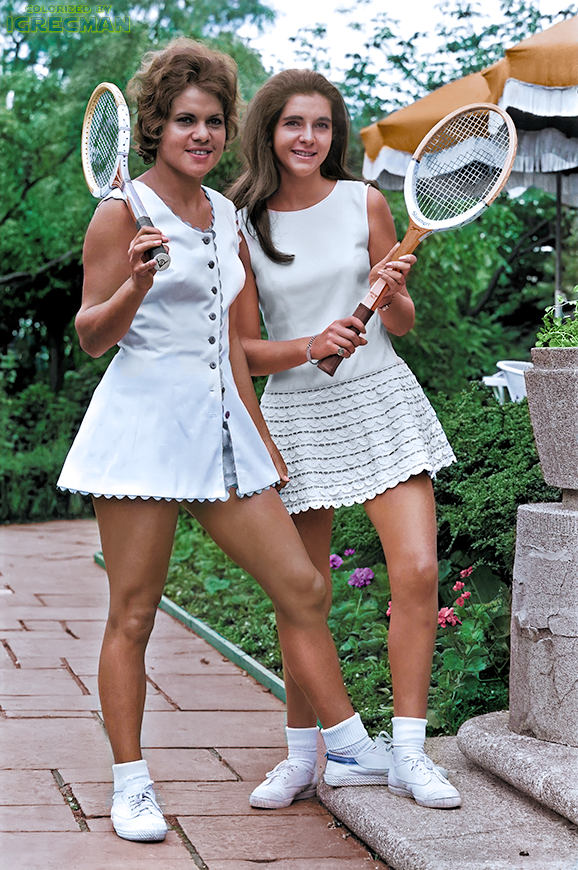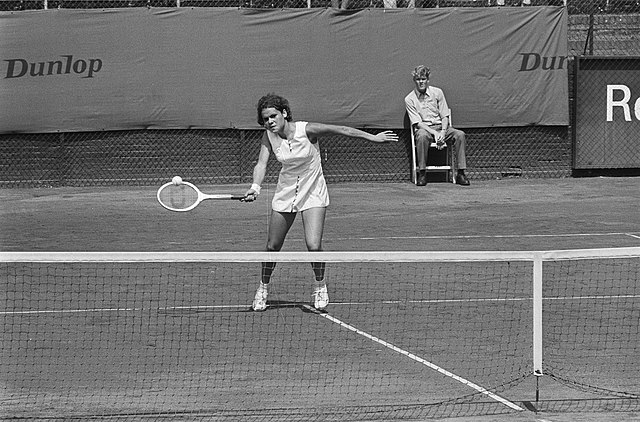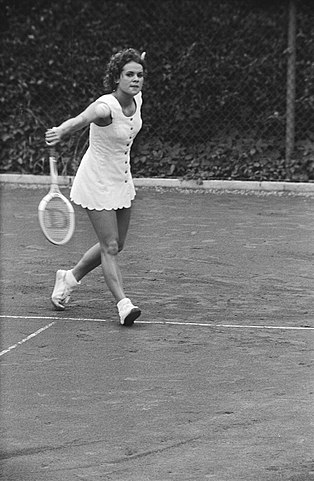In 2022, I’m counting down the 128 best players of the last century. With luck, we’ll get to #1 in December. Enjoy!
* * *
Evonne Goolagong [AUS]Born: 31 July 1951
Career: 1968-83
Plays: Right-handed (one-handed backhand)
Peak rank: 1 (1971)
Peak Elo rating: 2,259 (2nd place, 1976)
Major singles titles: 7
Total singles titles: 92
* * *
When Evonne Goolagong won Wimbledon the first time, in 1971, she did so ahead of schedule. She was only 19 years old, making her second appearance at The Championships after a second-round exit the year before. Her mentor, Vic Edwards, had long predicted that everything would come together for her three years later, in 1974.
Not only did Goolagong beat expectations, she did so in particularly convincing style. She lost only one set in seven rounds. Most impressive of all, she beat Billie Jean King and Margaret Court, back-to-back, in the semi-finals and final. The two women had won six of the last eight Wimbledon titles, and King would bounce back to win three of the next four.
One way to put Evonne’s achievement in context is in the form of a trivia question. How many players ever defeated both King and Court in the same tournament?
Answer: 3. Darlene Hard did it twice in 1963, before Billie Jean was the dominant force she’d become. Ann Jones upset both to win Wimbledon in 1969. Goolagong was the third.
Now, here’s the truly impressive thing. Once Court and King had faded, women’s tennis had another equally dominant duo in Chris Evert and Martina Navratilova. Between 1974 and 1989, only seven players beat that pair in the same event.
Rosie Casals did it in 1974, when Martina was still a chubby teenager. Tracy Austin and Andrea Jaeger each managed it as they moonballed their way to superstardom. Hana Mandlíková defeated the pair at events in both 1981 and 1985. Steffi Graf and Helena Sukova each accomplished the feat at the tail end of the Chrissie-and-Martina era.
The seventh woman to beat both Evert and Navratilova at the same tournament was–you guessed it–Evonne Goolagong. She ran the gauntlet to win the 1976 Virginia Slims Championships. Two years later, she once again stared down the most difficult of draws at the 1978 Slims of Boston.
All four of these all-time greats–Court, King, Evert, and Navratilova–won the majority of their meetings with Goolagong, most of them by a wide margin. But on a good day, Evonne could beat anybody. Throughout the 1970s, she had a lot of good days.
* * *
Goolagong reached 18 major singles finals, including 16 in one 20-event span. Yet tennis writers at the time tended to focus on Goolagong’s lapses. She once let it slip that she and Edwards referred to her off-moments as “walkabouts,” and from that moment on, no story about her was complete without the w-word.
Evonne’s path to stardom was an unusual one. An Aboriginal Australian raised in the tiny country town of Barellan, she was encouraged by a local man named Bill Kurtzman from the age of nine. Edwards, an accomplished coach with his own tennis school in Sydney, heard about the young talent and whisked her off to the city. Edwards’s eye was not flawless–he passed on a young Margaret Smith–but it would have been tough to miss Goolagong’s potential.
Even as a twelve-year-old, Goolagong’s backhands–both the volley and the slice groundstroke–were essentially the same weapons that would bedevil a generation of tour players. Edwards needed only to build a game around that.
The young woman’s game still looked like a natural gift after years of training at the Edwards academy. Fellow player Julie Heldman told the journalist Grace Liechtenstein in 1973, “She doesn’t seem conscious of her body at all, it just works for her.” Dress designer Teddy Tinling dubbed her “Nature’s child.”
Chris Evert said, “Evonne plays tennis the way black people dance.” While that one–like most comments about her athleticism and natural gifts–was intended as a compliment, there was often a tinge of racism. Goolagong didn’t face nearly as much bigotry away from Australia as she had at home–apartheid South Africa made her an honorary white so she could play tournaments there–but she was frequently reminded that she was a little different.
Other observers found more creative ways to describe Evonne’s talents. A male player told Liechtenstein, “She’s the only one of the girls who wears a jock”–that is, the Australian played an athletic brand of tennis that would have been more at home in the men’s game.
Billie Jean King said after a loss to Goolagong in 1974, “She was like a panther compared to me. She had more mobility and she played beautifully. I started watching her, and then I’d remember all of a sudden that I had to hit the ball.”
* * *
What made Evonne’s gifts that much more vexing to her opponents was that she hardly appeared to be trying. She rarely got frustrated; a mistake was more likely to trigger a grin than a show of frustration.
Goolagong was an adept net-rusher, though rush isn’t quite the word for it. Navratilova said in 2005, “She didn’t serve-and-volley; she would sort of saunter-and-volley.”
Most players raced to the net to avoid needing to hit a first volley from deep behind the service line in no-man’s land. Goolagong didn’t appear to care. In the 1971 Wimbledon final, she serve-and-volleyed 35 times, winning 25. Even with her lack of urgency, she put away nine of her first volleys for clean winners, and Court passed her only twice.
As celebrated as her backhand volley was, Evonne could win from the baseline as well. Her career winning percentage on clay, 83%, was identical to her mark on grass. She took the Roland Garros title on her first appearance there. She may well have won it again, but after the French Open banned World Team Tennis players in 1974, Goolagong skipped the event until 1983.
The Australian could beat most of the women on the circuit without much effort at all. In 1973, she hesitated to join the fledgling Virginia Slims circuit, playing federation-approved events instead. Against the divided competition that season, she won 106 matches, including 13 titles. She beat nearly everyone except for Evert, Court, and Virginia Wade.
The only way to get Goolagong fully engaged on court was to play well enough to challenge her. She wrote that “the most fun is catching up with and hitting a ball that looks impossible to reach.” Like the balletic Maria Bueno, to whom she was often compared, her “greatest high was to hit a ball well, to try to do it perfectly.”
* * *
Evonne’s easygoing quest for excellence allowed her to rack up victories and titles, but it left her peers wondering if she could ever become a truly dominant player in the mold of King and Court.
Some fellow players questioned whether Goolagong had the necessary killer instinct. (“Uh, you know, I won Wimbledon without the killer instinct,” Evonne replied.) Billie Jean thought that she hadn’t fully committed herself, and she wouldn’t be a “real champ” until she did.

Colorization credit: Women’s Tennis Colorizations
These were strange things to say in 1973 about a player who had reached the final of seven of the previous nine majors. (And she skipped one of the other two!) Yet from 1972 on, Goolagong was never ranked number one by the journalists who published their year-end top-ten lists. She only briefly held the top position on the WTA computer, in 1976. My historical Elo ratings are even harsher still, setting her peak ranking at number two. By the Elo formula, her most common year-end status was fourth place.
Coach Edwards told Grace Liechtenstein that Evonne’s “mind hasn’t matured. When it does, she could be on top for years … except that I reckon one of these days she’ll meet some handsome guy, run off and get married.” Edwards didn’t have a lot of faith in the doggedness of his charge, figuring that she couldn’t manage both tennis and a family.
He got that wrong. Goolagong married Roger Cawley, a former British junior player, in 1975, and she quickly ditched Edwards’s coaching and all-encompassing management in favor of her husband. In 1976, her first full season with Cawley, she lost only six matches, five of them to Evert. She reeled off one winning streak of 26 matches, including two victories apiece over Evert and Martina Navratilova.
Joe Jares of Sports Illustrated reported the consensus view of why Evonne was suddenly winning so much. “[T]hese days Goolagong … is actually paying attention.”
* * *
In 1977, Goolagong and Cawley had their first child, a daughter, Kelly. Evonne missed a year, but continuing to defy Edwards’s forecast, she had her eye on a comeback from the day she discovered she was pregnant. She trained throughout the pregnancy, and she came back five pounds lighter than she left.
She struggled with injuries throughout the early days of her comeback and again a couple of years later, but when she made it on court, she usually won. She reeled off 20 straight victories on the Australian circuit at the end of 1977, culminating in a title at the Australian Open. It was her fourth championship there and her sixth major overall. She added three titles in North America in early 1978, including her second tournament win with victories over both Evert and Navratilova.
In her absence, though, Chrissie and Martina had tightened their stranglehold on the game. In 1978, Navratilova stopped Evonne in the Wimbledon semi-finals. The next year, Evert straight-setted her at both Wimbledon and the US Open.
Goolagong later said, “Everyone had written me off and I was determined to prove a point. I had to show myself and everybody else that I was still competitive.” Winning a few titles on the Slims circuit was one thing, and she did pile up 17 tournament victories in the three years after Kelly was born. But majors were another story. While Margaret Court won three slams the year after her first child was born, no mother had been crowned Wimbledon champion since 1914.
The first half of 1980, when Evonne was 28, didn’t offer much hope. She struggled with illness and injury, and even worse, she couldn’t solve the riddle of Navratilova, who beat her four times in a span of three months. At the Wimbledon warm-up in Chichester, she lost to Evert for the fourth straight time.
Fans tend to remember the 1980 Wimbledon championships for its Borg-McEnroe men’s final, but Goolagong’s feats at the tournament were nearly as impressive. She overcame one-set deficits against former finalist Betty Stöve and youngster Hana Mandlíková in the third and fourth rounds, then made quick work of sixth seed Wendy Turnbull in the quarters. Against 17-year-old Tracy Austin in the semi-finals, she endured a bona fide Goolagong walkabout, dropping the second set 6-0, but bounced back to reach the final.
Nine years after her first triumph at the All-England Club, Evonne did it again. Facing Evert just three weeks after the loss in Chichester, the veteran won in straight sets, 6-1, 7-6. She took 30 of 52 net points against the best baseline player of her generation, allowing Evert only four passing-shot winners. Killer instinct or no, she repeatedly slammed the door whenever Chrissie got close, saving 9 of 13 break points.
Goolagong proved her point. She is the only Wimbledon champion to beat four top-ten seeded players en route to the title. She remains only the second mother to claim the title. She will surely always be the only woman from Barellan, New South Wales to win the most coveted trophy in tennis.

